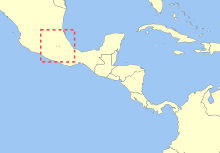Teporingo
| Volcano rabbit | |
|---|---|
 |
|
| Scientific classification | |
| Kingdom: | Animalia |
| Phylum: | Chordata |
| Class: | Mammalia |
| Order: | Lagomorpha |
| Family: | Leporidae |
| Genus: |
Romerolagus Merriam, 1896 |
| Species: | R. diazi |
| Binomial name | |
|
Romerolagus diazi (Ferrari-Pérez, 1893) |
|
 |
|
| Volcano rabbit range | |
The volcano rabbit (Romerolagus diazi), also known as teporingo or zacatuche, is a small rabbit that resides in the mountains of Mexico. It is the world's second smallest rabbit, second only to the pygmy rabbit. It has small rounded ears, short legs, and short, thick fur and weighs approximately 390–600 g (0.86–1.3 lb). It has a life span of 7 to 9 years. The volcano rabbit lives in groups of 2 to 5 animals in burrows (underground nests) and runways among grass tussocks. The burrows can be as long as 5 m and as deep as 40 cm. There are usually 2 to 3 young per litter, born in the burrows.
Unlike many species of rabbits (and similar to pikas), the volcano rabbit emits very high-pitched sounds instead of thumping its feet on the ground to warn other rabbits of danger. It is crepuscular and is highly active during twilight, dawn and all times in between. Populations have been estimated to have approximately 150–200 colonies with a total population of 1,200 individuals over their entire range.
Volcano rabbits are an endangered species endemic to Mexico. Specifically, the rabbit is native to four volcanoes just south of Mexico City, the largest of which is called El Pelado. The range of the volcano rabbit has been fragmented into 16 individual patches by human disturbance. Vegetation within the patches include Nearctic and Neotropical varieties. Elevation of these patches is between 2900 and 3660 meters above sea level. The soil consists mostly of Andosol and Lithosol. The local climate is temperate, subhumid, and has a mean annual temperature of 11 °C. Annual rainfall averages at about 1000 millimeters. In the patches that are the most heavily populated with volcano rabbits, the plants Festuca tolucensus and Pinus hartwegii are most abundant. Volcano rabbits show strong preferences for habitat types that are categorized as pine forests, open pine woodland, and mixed alder pine forest. Human activity in the area has had a great impact upon the preferred habitat of the volcano rabbit. Humans have fragmented the rabbits' habitat by constructing highways, farming, burning, and allowing grazing. Ecological fragmentation has been caused by environmental discontinuity.
Volcano rabbits are commonly found at higher altitudes. Almost 71% of volcano rabbits are found in pine forests, alder forests, and grasslands. R. Diazi is a gnawing animal that is distinguished from rodents by its two pairs of specialized upper incisors that are designed for gnawing. Volcano rabbits are more abundant near tall, dense herbs and thick vegetation, and are adversely affected by anthropogenic environmental disturbances like logging and burning. A study on the effects of climate change upon volcano rabbit metapopulations concluded that fluctuations in climate most affected rabbits on the edge of their habitable range. The volcano rabbit's range encompasses a maximum of 280 km2 of grasslands in elevated areas in the Trans-Mexican Neovolcanic Belt.
...
Wikipedia

